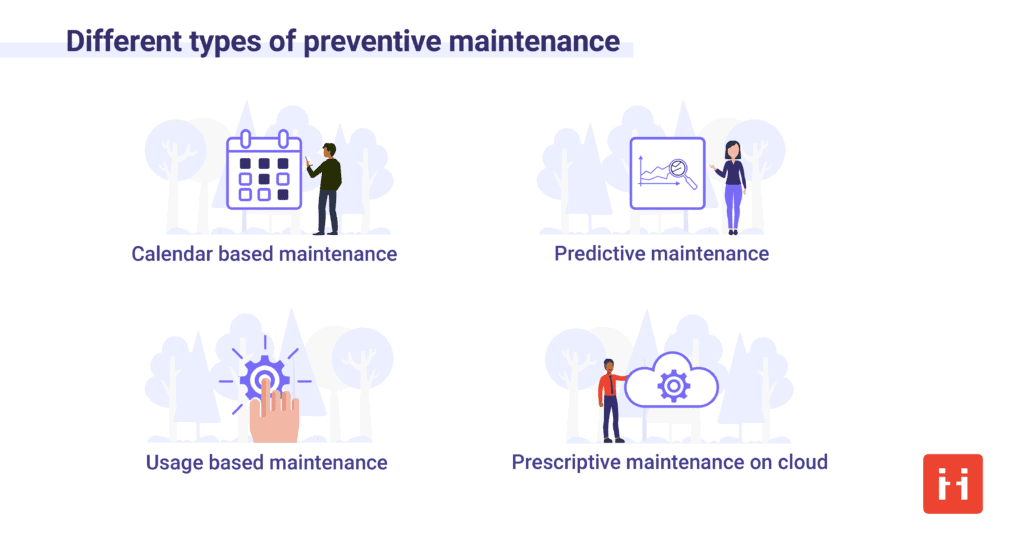
Share this article
Share this article
Whether you are working in an office or factory, taking care of your equipment is essential. This will help avoid unexpected breakdowns, which will incur unnecessary costs. A maintenance program should be part of your everyday management strategy to prevent equipment malfunction. The good news is that you can use different types of preventive maintenance strategies depending on your budget, service level, and equipment needs.
Preventive maintenance, or PM, is one maintenance strategy you can use to increase the life expectancy of your assets and cut down on costs. If you want to understand more about PM, read on to know what it is and some of the different types of preventive maintenance available.
Preventive maintenance involves regular equipment inspection to ensure no minor problems are present, which will make the machines fail to function. Some of the other activities may include lubrication, calibrations, cleaning, adjustments, and parts replacements. This maintenance strategy aims to eliminate unexpected downtime and extend the life of the business assets.
Preventative maintenance refers to taking immediate action and precautions to ensure equipment failure or accidents do not occur. Its goal is to reduce the probability of business assets failure and cut down on the unnecessary cost of replacing equipment.
This means that you have to focus on boosting the performance of what is already working instead of fixing broken equipment.
Preventive maintenance activities should be part of your management plan to ensure everything runs smoothly in the workplace. Machine breakdown can cause a lot of inconveniences and may end up being costly and time-consuming. This is why you should adopt this maintenance strategy for your company as it will help with the following:
• Boost customer and workers safety;
• Prevent costly repairs in the long run;
• Keep equipment functionality intact.
The best part is that there are different types of preventive maintenance that you can use depending on the business area and timeframe. Some may include time-based maintenance, predictive maintenance, usage-based maintenance, etc. Below, we shall look at what they entail and how they can benefit your company or business.
Preventive and corrective maintenance are some of the maintenance strategies used in many facilities. Their main difference is in the maintenance service time and, in some cases, the equipment. In preventive maintenance, equipment or asset failure are prevented before they happen, just like the name suggests. This means machines are inspected even when they are still in good condition.
On the other hand, corrective maintenance is performed only when equipment has failed or malfunctioned. The strategy is mainly used on equipment that does not change or interfere with the business’s productivity.

This strategy is also known as time-based maintenance and involves regularly checking or inspecting business assets at a specified time. The business assets are checked whether they are in good or bad condition. The time can be set after a few days, weeks, or even months and usually depend on the manufacturer’s recommendations or equipment performance.
Here are a few examples that can help you understand this maintenance program.
• Cleaning your gutter after every six months
• Inspecting business fire extinguishers every month
• Carrying out maintenance services on air-conditioners before summer
• Lubricating all machines after every two weeks
• Turning up the furnace before winter
Calendar-based maintenance strategy is suitable for short-life assets like fire extinguishers, gate motors, pumps, etc. One advantage of using this strategy is that it offers better preparation for the upcoming task. It lets you know all the parts, supplies, and labor required for the job to be completed before its due date. Another positive is that it takes less workforce. This is because the machine or equipment is regularly checked, and therefore, it may still be in good condition or needs a slight improvement to make it better.
Lastly, time-based maintenance further improves the functionality of business assets, especially if you have a habit of indicating problems and previous breakdowns that occur. This allows you to know which equipment requires extra care, so you can extend the equipment lifetime.

Usage-based maintenance, or UBM, refers to scheduling and planning maintenance services based on the utilization of the machinery or equipment. This maintenance strategy uses metrics like operating hours, equipment monitors, and production cycles to schedule maintenance programs. For example, important machinery or a vehicle has covered X amount of hours and needs maintenance to ensure it works efficiently.
This type of preventive maintenance uses meter readings, which helps to reflect the machinery utilization. To carry out this successfully, you need to set your UBM on preventive maintenance software.
Predictive maintenance refers to a technique that utilizes data-driven and analysis tools to detect and signal anomalies in business operations. It shows the possible defects in the machinery so that you can take care of them before the entire process fails.
This type of maintenance strategy reduces the frequency of machine downtime, and this helps prevent unnecessary costs. It follows a very systematic process to ensure machines are functioning normally and maintenance is done when necessary. The steps involved include the following:
• Determining the equipment that will be monitored
• Establishing a frequency
• Monitoring the condition of the equipment and issuing a report
• If there are any abnormalities, come up with a work order
• Plan the maintenance date
• Ensure all the material, parts, and technicians are available
• Finally, close the work order and continue monitoring the machinery.

Predictive maintenance takes advantage of real-time asset data to determine if there are any problems in the operation before it occurs. It focuses on three areas of the business. They include the following:
• Real-time monitoring of the performance and condition of the asset
• Analyzes the work order data
• Benchmarking of the maintenance, repair, and operations (MRO) inventory usage.
Predictive maintenance programs work effectively for many businesses. The best thing about them is that maintenance is done only when necessary. Some of the other benefits of this strategy are:
• Reduces unexpected breakdowns
• Boosts asset reliability and uptime
• Improves safety
• Increases production hours
• Minimizes maintenance cost since inspections and corrections are done when necessary
Prescriptive maintenance strategy or RxM uses artificial intelligence and machine learning to analyze and collect information about the machinery condition. It uses technologies and histories to make tests and assumptions on the business assets. In short, the software uses trends to make recommendations for the maintenance of the assets.
The AI software helps you detect when machine failure will occur, which will help you prevent that before the due date. It can also determine the cause impacting the equipment fault and propose a better approach to fixing the problem.
Some examples of prescriptive maintenance applications include:
• Facilities: RxM can be applied in facility pumps. The AI tool can detect any defects in the pump, which will help determine whether they need cleaning or replacement.
• Automotive: A prescriptive maintenance plan can be used in automotive plants to increase production and reduce cost and labor.
• Pharmaceuticals: Cleanroom shutdowns can incur a lot of unnecessary costs on a pharmaceutical facility. MLA (machine learning logarithms) can help determine when to carry out prescriptive maintenance to avoid shutdowns.
AI tools can significantly help improve operations in your business because they help you determine when to carry out maintenance programs before a breakdown occurs. Another thing is that they also help propose suggestions of what can be done to improve the situation. Other benefits that come with prescriptive maintenance are:
• It optimizes maintenance operations;
• Improves assets life, uptime, and machinery performance;
• Boosts efficiency and reduces downtime.

You can use different types of preventive maintenance depending on your assets, manufacturer’s instructions, and timeline. Above are a few maintenance strategies that can improve the performance of your machinery and help cut down operational costs.
Free E-book available now!